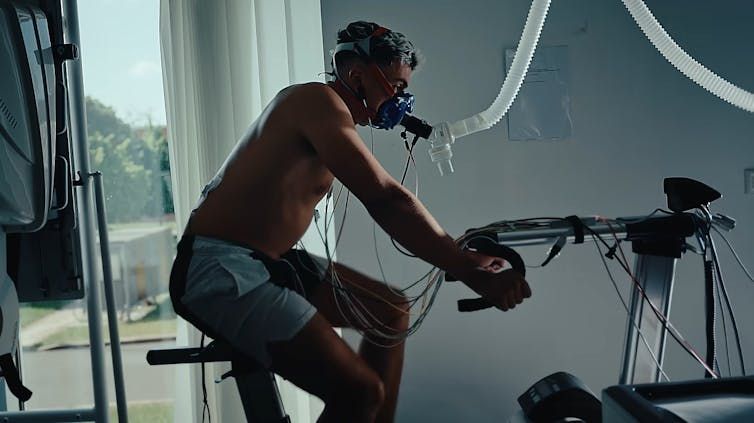The Kaizen documentary by French YouTuber Inoxtag, which recounts his preparation for the ascent of Everest over a period of one year, has generated many reactions, mainly positive. However, we can rightly question the abusive call he makes to surpassing oneself, which he applies to himself in the documentary, and which he attempts to promote among adolescent people of his community.
A majority of his approximately 20 million subscribers have indeed praised the feat and personal accomplishment achieved by the young French YouTuber. In doing so, she recognized in him a true “cultural prescriber”.
Others, more critical, have highlighted the dazzlingness of its entrepreneurial success, but also the instrumentalization of certain values, such as sport, in the service of a meritocratic discourse. Still others criticized him for selling an “imaginary of unlimited resources when we have an environmental imperative of sobriety”.
(Youtube | Inoxtag)
As a professor and specialist in organizational intervention and communication at the University of Quebec in Montreal, I would like to discuss the dangerous misdirection of self-improvement or continuous improvement (also known as Kaizen as a practice of improving performance). performance in organization) in way of living.
A major project
Inoxtag has impressive influence to convey its messages. All of its digital platforms have more than 20 million subscribers. Among them, his YouTube channel is the largest, with 8.66 million subscribers.
His recent documentary, “KAIZEN: 1 year to climb Everest!” » also has something to seduce. Aimed at an audience mainly made up of young adolescents, the documentary relays a positive message where “surpassing oneself” is in the spotlight.
The material, human and financial resources are also there. In addition to documenting all the stages of his adventure, Inoxtag climbed Everest accompanied by his friends, each of whom cost more than $75,000 to attend.
The editing is careful while the images are breathtaking. The moments of introspection are meant to be spontaneous and sincere, the advertising incises subtle, but effective. In short, the documentary has something to fascinate and make you dream.
Kaizen: a truncated definition
Lasting 2 hours 26 minutes, the documentary is called “Kaizen”. However, it is only at the very end that we learn the definition.
The Japanese word composed of [Kai]which means “change”, and [Zen]which means “for the better” or “better”, has designated since the 1950s a process of continuous improvement in the service of management. It designates the desire to strategically improve production excellence within ultra-competitive environments.
If this process first concerned the manufacturing sector, after the war, it gradually extended to other sectors, such as services or the civil service for example. Since then, we have witnessed a misdirection of the term, which little by little designates an attitude which sanctifies performance as an unsurpassable horizon.
Instrumentalization of Kaizen
Kaizen, as a performance improvement practice in an organization, first responds to the attempt to eliminate waste. In doing so, it is part of the management philosophy called Lean, which consists of “always doing more with less”. Kaizen invites organizational employees to understand how the situation could be improved, to design avenues for improvement, to contribute to the development of solutions and to implement them.
Already thousands of subscribers to the La Conversation newsletter. And you ? Subscribe today to our newsletter to better understand the major contemporary issues.
However, this “meaning block” of continuous improvement primarily serves the interests of the organization and not those of the people who put it into action (typically the people employed by the organization). In this case, continuous improvement acts on two levels. First, it benefits Inoxtag itself, which uses continuous improvement as a mantra that it periodically distils to its community. Then, although in a more subtle way, it serves the YouTuber’s commercial partners, who obtain visibility and publicity by having made his adventure possible.
We are therefore witnessing an aestheticization of total performance, the new spirit of capitalism.
The body as a staging of continuous improvement
Worse, the body, through its physical activity of surpassing itself, becomes the object of this continuous improvement. The depiction of the body which suffers and surpasses itself in order to climb Mount Everest aestheticizes continuous improvement, making it desirable.
In addition to being powerfully and socially internalized and prescribed as “positive” (who doesn’t want to improve?), continuous improvement seems to me in these conditions likely to become an insatiable quest creating suffering and exhaustion. After all, you can only do what a body can.

(Youtube | Inoxtag)
It also refers to the sole responsibility of the individual, deliberately excluding any material, relational and social dimension. To what extent do the material conditions of existence allow a person to take on any challenge, or to begin any “project”? Is it even possible to give yourself these kinds of ambitions without being solidly surrounded (parents, mentors, friends, significant referents of all kinds)?
Questioning continuous improvement
In his documentary, Inoxtag makes comments that relate directly to continuous improvement: “I want to be a new man”, “every day to be better than yesterday”, he says for example. By naturalizing this continuous improvement as irrefutable and raising it to the rank of a new anthropological fact, we take the risk of raising hyperperformance to the rank of sole existential purpose without asking ourselves if it still makes sense.
I understand that we can be positively affected by this type of message and by the values it claims to embody, such as courage, perseverance and surpassing oneself. I also understand that one can feel great bodily pleasure from putting one’s values into action.
However, this enthusiasm for continuous improvement reveals in the background the toxic effects of a capitalist structure which values and validates this enthusiasm (at the same time at the social, organizational and individual level) to the point of exhaustion, until until the body can’t take it anymore.
We must therefore radically question this “false evidence” and forcefully reaffirm that self-improvement as continuous improvement is first and foremost the symptom of an individual, silent and destructive enjoyment which morally enslaves more than it does. emancipates, even if its flashy appearances are pleasant to contemplate, even to imitate.








